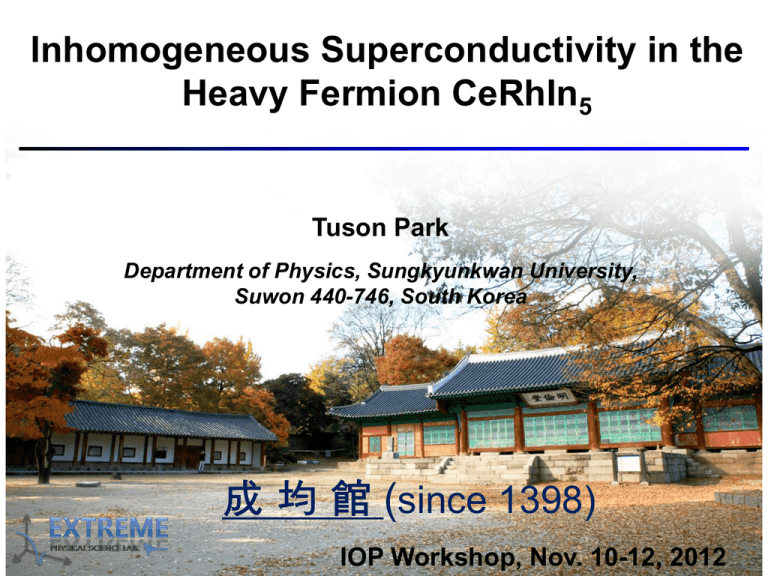Tuson_Park_files/Tuson_beijing IOP 2012 Nov
advertisement

Inhomogeneous Superconductivity in the
Heavy Fermion CeRhIn5
Tuson Park
Department of Physics, Sungkyunkwan University,
Suwon 440-746, South Korea
成 均 館 (since 1398)
IOP Workshop, Nov. 10-12, 2012
Collaborators
E. Park, S. Seo, S. Lee, D. Shin, S. Shin
: Sungkyunkwan Univ.
X. Lu, H. Lee, F. Ronning, E. D. Bauer, R.
Movshovich, J. L. Sarrao, I. Martin, Z. Zhu, J. D.
Thompson: Los Alamos National Lab.
H. Q. Yuan: Zhejiang University, China
V. Sidorov: HPPI, Russia
Z. Fisk: Univ. California - Irvine
I. Vekhter: Louisiana State Univ.
N. Curro: Univ. California - Davis.
R. R. Urbano: UNICAMP.
SKKU
Outline
Quantum criticality and superconductivity
Inhomogeneous SC state in the quantum critical
superconductor CeRhIn5
- Phys. Rev. Lett. 108, 077003 (2012)
Disorder, magnetism, and superconductivity:
Cd-doped CeMIn5 (M=Co, Rh, Ir)
(unpublished)
Phase diagram of unconventional SCs
cuprate
organics
Fe-based pnictides
heavy fermion
CeRhIn5
Non-Fermi liquid at optimal Tc
cuprate
Fe pnictides
Common threads
heavy fermion
100
Universial Class of SCs
0.6
CeRhIn
T 5
10
c (-cm)
organics
CeRhIn5
1
2
T
0.1
1
1 bar
22.7 kbar
52.6 kbar
10
100
Temperature (K)
temperature
Emergent phases near a quantum critical point
Quantum critical
matter (NFL)
Ordered
Ordered
state state
SC
Fermi
liquid
δc
temperature –control parameter (δ)
phase diagram
δ
P. Coleman & A. J. Schofield, Nature 433 ('05)
Quantum phase transition is a transition
between ordered and disordered states
driven by quantum fluctuations at T = 0 K
Breakdown of Fermi liquid: Δρ Tn (n <2), C/T log T0/T
Continuous source of new emergent states:
unconventional superconductivity, metamagnetism (Sr3Ru2O7),
stripes in the cuprates, nematic states in URu2Si2 & Fe-based SCs
Quantum critical superconductivity in CeRhIn5
100
I // ab-plane
2.3 K
20 K
50 K
280 K
ab
(P)
(P) // abab (5.2
(5.2 GPa)
GPa)
ab
80
60
40
20
0
0
1
2
3
4
5
P (GPa)
[100]
[010]
[100]
905
SC
900
C / T (a. u.)
Isothermal measurements of CeRhIn5 as
a fn of pressure: (P) / (5.2 GPa)
Nature 456, 366 (2008)
1.8 K
& 0.5 T
895
330
328
326
Quantum fluctuations are the origin of the
unconventional superconductivity
0.3 K
& 0.5 T
324
0
90
180
angle ()
4-fold modulation in field-angle specific heat
PRL 101, 177002 (2008)
Outline
Quantum criticality and superconductivity
Inhomogeneous SC state in the quantum critical
superconductor CeRhIn5
- Phys. Rev. Lett. 108, 077003 (2012)
Disorder, magnetism, and superconductivity:
Cd-doped CeMIn5 (M=Co, Rh, Ir)
(unpublished)
ab (m cm)
Textured SC in high-Tc cuprates
10
-1
10
-2
10
-3
10
-4
La1.875Ba.125CuO4
bulk Tc
0
10
20
30
40
50
T (K)
Q. Li et al., PRL 99, 067001 (2007)
resistive transition far above bulk Tc
Broad tail below the Tc onset
temperature for transition in c < ab
I. Martin & C. Panagopoulos, EPL
92, 67001 (2010)
Y. Ando et al., PRL 92, 247004 (2004)
Filamentary superconductivity in CeRhIn5
Filamentary superconductivity
due to bad sample quality?
Manifestation of a new state of
matter in the vicinity of a QCP?
Tc difference below 1.9 Gpa
(Knebel et al., JPCM 16, 8905 (2004))
Experiments: simultaneous measurements of heat
capacity and resistivity under pressure
Hybrid clamp-type pressure cell
(up to 3 GPa) with silicone as
transmitting medium
Plug with samples mounted
Pb Tc as a meausre of pressure
CeRhIn5 in the coexisting phase
TN
12.0
TN
bulk Tc
6000
Tc onset
T (K)
C/T (arb. units)
4
2
AFM
10.0
P = 15.8 kbar
Ton
8.0
4000
6.0
4.0
2000
SC
2.0
AFM+ SC
0
0.0
0.5
1.0
1.5
2.0
2.5
P (GPa)
Phase diagram for better sample with
RRR ~ 1000
0
0.0
0
1
2
3
4
T (K)
Tc
Tc onset in the resistivity is different
from the bulk Tc determined by the
heat capacity
ab ( cm)
6
Pressure effects on the Tc difference
a
a
Tc onset
C/T (arb. units)
6000
bulk Tc
c
b
T (K)
4
0
0.0
1.0
2.0
3.0
0.0
4.0
1.5
2.0
2.5
P (GPa)
Tc difference between resistivity and
specific heat only in the coexisting
phase
Tc difference is not from disorder,
but from competing orders
10.0
P = 1.7 GPa
GPa
2000
5.0
0
0.0
1.0
2.0
3.0
ab ( cm)
1.0
4000
0.0
4.0
c
6000
10.0
P = 2.2 GPa
4000
5.0
2000
0
0.0
1.0
2.0
3.0
ab ( cm)
AFM+ SC
0.5
5.0
2000
b
SC
0
0.0
4000
AFM
C/T (arb. units)
2
10.0
P = 1.58 GPa
GPa
ab ( cm)
TN
C/T (arb. units)
6
0.0
4.0
T (K)
TP et al., Phys. Rev. Lett. 108, 077003 (2012)
Resistivity anisotropy in the SC transition regioin
6
TN
bulk Tc
Tc onset
10.00
10.00
T (K)
,,
ab
cc ((
-cm)
-cm)
ab
4
1.00
1.00
(ab)
ab)
bar(J(J
////ab)
11bar
1.61
GPa
(ab)
// ab)
1 bar (J // c)(J
2.42 (J
GPa
// c)(ab)
1bar
1bar GPa
(c) (J // c)
1.65
1.65 GPa (c)
2.43 GPa (c)
0.10
0.10
cm
cm
90nn
(0)==90
c(0)
cc
2
AFM
SC
AFM+ SC
0
0.0
0.5
1.0
1.5
2.0
2.5
P (GPa)
cm
cm
7.9nn
(0)
(0)==7.9
ab
ab
ab
0.01
0.01
1.0
1.0
2.0
2.0
3.0
3.0
4.0
4.0
5.0
5.0
T(K)
T(K)
At 1bar, residual resistivity for J//c is larger
than J // ab by a factor of 10
Contradicting conventional expectation,
however, resistivity drops to zero immediately
for J // c, while it has a long tail for J // ab
Resistivity anisotropy only
in the coexisting phase
Textured SC state
Broad tail of SC transition in ρab is not
from heating effects.
Additional in-plane anisotropy
1.00
( cm)
1.00
P = 1.58 GPa
@ 0.1 mA
@ 10.0 mA
0.10
0.01
0.10
1.6
1.8
2.0
2.2
2.4
1.6
1.7
T (K)
2.2
I//100
I//110
3.0
2.0
1.0
T (K)
Tc, mid (K)
ab (-cm)
10.00
I//100
I//110
2.0
c
1.8
AF
SC
AF
SC
b
AF
a
1.3
1.4
1.5
P (GPa)
Recent neutron scattering in the coexisting phase of
CeRhIn5
4
Tc
TN
T (K)
3
AFM
2
SC
1
AFM+ SC
0
0.0
0.5
1.0
1.5
2.0
2.5
P (GPa)
T*Tcorresponds
to resistive T
c corresponds to the bulk Tc, cwhere
=>
& Q2 coexists, while Q1
QSC
2 completely replaces Q1 and
disappears
below
bulk Tc
coexists with
SC state
c
Q1
Neutron scattering of CeRhIn5 at 1.48 GPa
- Aso et al., JPSJ 78, 073703 (2009).
SC & Q1 SC & Q1
Q2
Q2
b
a
Q1 = (0.5, 0.5, 0.326), Q2 = (0.5, 0.5, 0.391)
Summary & Discussion I
Discovery of a textured SC
phase in the heavy fermion
compound CeRhIn5:
- Tc difference
- Resistivity anisotropy among
different crystalline axes
- Coincidence of Q2 onset with Tc
onset
Presence of competing phase &
proximity to a QCP are keys to
the textured SC phase
Is textuerd SC unique in CeRhIn5?
c
Q1
SC & Q1 SC & Q1
Q2
Q2
b
a
Q1 = (0.5, 0.5, 0.326), Q2 = (0.5, 0.5, 0.391)
ab (m cm)
Textured SC in high-Tc cuprates
10
-1
10
-2
10
-3
10
-4
La1.875Ba.125CuO4
bulk Tc
0
10
20
30
40
50
T (K)
Q. Li et al., PRL 99, 067001 (2007)
resistive transition far above bulk Tc
Broad tail below the Tc onset
temperature for transition in c < ab
I. Martin & C. Panagopoulos, EPL
92, 67001 (2010)
Textured SC in organics
(TMTSF)2PF6
Pasquier et al.,
Physica B 407, 1806 (2012)
pressure
Textured SC in Fe pnictides
Fernandes et al.,
Phys. Rev. B 81, 140501 (2010)
Chu et al., Science 329, 824 (2010)
(arXiv:1112.2243v1)
Perspective on textured state
Quantum critical SCs seem susceptible to new
electronic states
Electrons spontaneously adjust themselves to
minimize the stress coming from frustration among
competing phases
Is textured SC state universal? Most likely
Add one more common thread to the
unconventional SCs
Is it beneficial to superconductivity? Probably not
in CeRhIn5
Thank you !
감사합니다!




